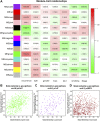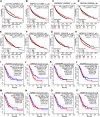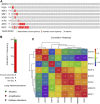Weighted Gene Co-Expression Network Analysis and Treatment Strategies of Tumor Recurrence-Associated Hub Genes in Lung Adenocarcinoma
- PMID: 34868230
- PMCID: PMC8636777
- DOI: 10.3389/fgene.2021.756235
Weighted Gene Co-Expression Network Analysis and Treatment Strategies of Tumor Recurrence-Associated Hub Genes in Lung Adenocarcinoma
Abstract
Despite the recent progress of lung adenocarcinoma (LUAD) therapy, tumor recurrence remained to be a challenging factor that impedes the effectiveness of treatment. The objective of the present study was to predict the hub genes affecting LUAD recurrence via weighted gene co-expression network analysis (WGCNA). Microarray samples from LUAD dataset of GSE32863 were analyzed, and the modules with the highest correlation to tumor recurrence were selected. Functional enrichment analysis was conducted, followed by establishment of a protein-protein interaction (PPI) network. Subsequently, hub genes were identified by overall survival analyses and further validated by evaluation of expression in both myeloid populations and tissue samples of LUAD. Gene set enrichment analysis (GSEA) was then carried out, and construction of transcription factors (TF)-hub gene and drug-hub gene interaction network was also achieved. A total of eight hub genes (ACTR3, ARPC5, RAB13, HNRNPK, PA2G4, WDR12, SRSF1, and NOP58) were finally identified to be closely correlated with LUAD recurrence. In addition, TFs that regulate hub genes have been predicted, including MYC, PML, and YY1. Finally, drugs including arsenic trioxide, cisplatin, Jinfukang, and sunitinib were mined for the treatment of the eight hub genes. In conclusion, our study may facilitate the invention of targeted therapeutic drugs and shed light on the understanding of the mechanism for LUAD recurrence.
Keywords: hub genes; lung adenocarcinoma; transcription factor; tumor recurrence; weighted gene co-expression network analysis.
Copyright © 2021 Shen, Liu, Liu, Liu and Yao.
Conflict of interest statement
The authors declare that the research was conducted in the absence of any commercial or financial relationships that could be construed as a potential conflict of interest.
Figures












Similar articles
-
Low expression of CHRDL1 and SPARCL1 predicts poor prognosis of lung adenocarcinoma based on comprehensive analysis and immunohistochemical validation.Cancer Cell Int. 2021 May 12;21(1):259. doi: 10.1186/s12935-021-01933-9. Cancer Cell Int. 2021. PMID: 33980221 Free PMC article.
-
Weighted gene co-expression network analysis of hub genes in lung adenocarcinoma.Evol Bioinform Online. 2021 Apr 12;17:11769343211009898. doi: 10.1177/11769343211009898. eCollection 2021. Evol Bioinform Online. 2021. PMID: 33911849 Free PMC article.
-
Co-expression network analysis identified KIF2C in association with progression and prognosis in lung adenocarcinoma.Cancer Biomark. 2019;24(3):371-382. doi: 10.3233/CBM-181512. Cancer Biomark. 2019. PMID: 30883337
-
Identification of Susceptible Genes for Chronic Obstructive Pulmonary Disease with Lung Adenocarcinoma by Weighted Gene Co-Expression Network Analysis.Onco Targets Ther. 2021 Jun 4;14:3625-3634. doi: 10.2147/OTT.S303544. eCollection 2021. Onco Targets Ther. 2021. PMID: 34113128 Free PMC article.
-
Identification of the susceptibility genes for COVID-19 in lung adenocarcinoma with global data and biological computation methods.Comput Struct Biotechnol J. 2021;19:6229-6239. doi: 10.1016/j.csbj.2021.11.026. Epub 2021 Nov 20. Comput Struct Biotechnol J. 2021. PMID: 34840672 Free PMC article.
Cited by
-
Aberrant expression of KDM1A inhibits ferroptosis of lung cancer cells through up-regulating c-Myc.Sci Rep. 2022 Nov 10;12(1):19168. doi: 10.1038/s41598-022-23699-4. Sci Rep. 2022. PMID: 36357457 Free PMC article.
-
Ribosome biogenesis and function in development and disease.Development. 2023 Mar 1;150(5):dev201187. doi: 10.1242/dev.201187. Epub 2023 Mar 7. Development. 2023. PMID: 36897354 Free PMC article. Review.
-
Development of a relapse-related RiskScore model to predict the drug sensitivity and prognosis for patients with ovarian cancer.PeerJ. 2025 Aug 11;13:e19764. doi: 10.7717/peerj.19764. eCollection 2025. PeerJ. 2025. PMID: 40821986 Free PMC article.
-
Overexpression of NOP58 Facilitates Proliferation, Migration, Invasion, and Stemness of Non-small Cell Lung Cancer by Stabilizing hsa_circ_0001550.Anticancer Agents Med Chem. 2024;24(16):1197-1206. doi: 10.2174/0118715206293943240615105417. Anticancer Agents Med Chem. 2024. PMID: 38994624
-
Inhibition of EZH2 Ameliorates Sepsis Acute Lung Injury (SALI) and Non-Small-Cell Lung Cancer (NSCLC) Proliferation through the PD-L1 Pathway.Cells. 2022 Dec 7;11(24):3958. doi: 10.3390/cells11243958. Cells. 2022. PMID: 36552722 Free PMC article.
References
LinkOut - more resources
Full Text Sources
Miscellaneous

